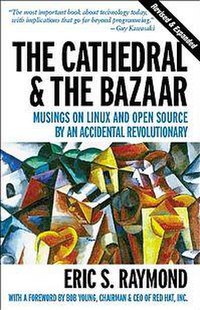The Cathedral and the Bazaar
From Wikipedia, the free encyclopedia
| The Cathedral and the Bazaar | |
 Cover of the paperback compendium edition |
|
| Author | Eric S. Raymond |
|---|---|
| Publisher | O'Reilly Media |
| Publication date | 1999 |
| ISBN | 1-56592-724-9 |
| Followed by | Homesteading the Noosphere |
The Cathedral and the Bazaar (abbreviated CatB) is an essay by Eric S. Raymond on software engineering methods, based on his observations of the Linux kernel development process and his experiences managing an open source project, fetchmail. It was first presented by the author at the Linux Kongress on May 27, 1997 and was published as part of a book of the same name in 1999.
Contents |
[edit] Content
The essay contrasts two different free software development models:
- The Cathedral model, in which source code is available with each software release, but code developed between releases is restricted to an exclusive group of software developers. GNU Emacs and GCC are presented as examples.
- The Bazaar model, in which the code is developed over the Internet in view of the public. Raymond credits Linus Torvalds, leader of the Linux kernel project, as the inventor of this process. Raymond also provides anecdotal accounts of his own implementation of this model for the fetchmail project.
The essay's central thesis is Raymond's proposition that "given enough eyeballs, all bugs are shallow" (which he terms Linus's Law): the more widely available the source code is for public testing, scrutiny, and experimentation, the more rapidly all forms of bugs will be discovered. In contrast, Raymond claims that an inordinate amount of time and energy must be spent hunting for bugs in the Cathedral model, since the working version of the code is available only to a few developers.
[edit] Legacy
The essay helped convince most existing open source and free software projects to adopt Bazaar-style open development models, fully or partially — including GNU Emacs and GCC, the original Cathedral examples. Most famously, it also provided the final push for Netscape Communications Corporation to release the source code for Netscape Communicator and start the Mozilla project.[1]
When O'Reilly Media published the book in 1999, it achieved another distinction by being the first complete and commercially distributed book published under the Open Publication License.
[edit] See also
[edit] Notes
[edit] References
- Eric S. Raymond (1999). The Cathedral & the Bazaar. O'Reilly. ISBN 1-56592-724-9. http://www.catb.org/~esr/writings/cathedral-bazaar/cathedral-bazaar/.

